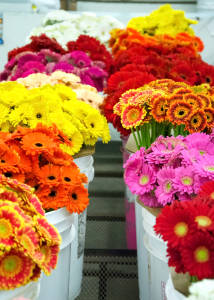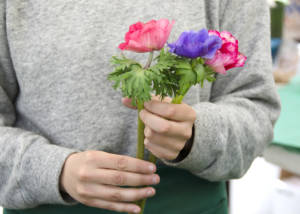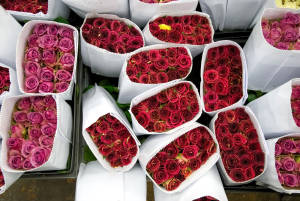
What You Can Do To Improve The Floral Industry
Though local, seasonal food has become a reliable mainstay, flowers are still a largely outsourced commodity, despite the similar challenges the two industries face, like being prone to spoil quickly and being subject to the utmost scrutiny from picky customers who won’t accept anything that looks less than perfect. But as consumer concerns expand beyond food, the floral industry is starting to shift as well– and Debra Prinzing is here to help that shift along.
Prinzing is the founder of Slow Flowers, a site that helps consumers find local florists, event planners, and flower farmers who use only American-grown flowers. In an attempt to draw attention to the Slow Flowers movement, Prinzing started American Flowers Week, which this year runs from June 28th and ends on July 4th and aims to promote visibility while engaging important stakeholders, from policymakers to retailers to consumers.
Below, we’ve put together all the essential info you need about the floral industry as it currently stands: its challenges, and how people are making (exciting!) changes.
What’s at Stake
Though flowers often get written off as a frivolous luxury, the industry is worth some $104 billion globally (that includes plants in gardens as well). More specifically, the total value of cut flower sales come out to $7.5 billion and 80% of flowers sold in the US are imported. Colombia accounts for 78% of the imported flowers, with Ecuador coming in second at 15%. In the United States, California dominates the American-grown market, making up 76% of the flowers grown– which isn’t surprising, considering all the stunning flowers farms you can visit there.
The Toll of Pesticides
At this point, the ill-effects of the floral industry’s byproducts all well documented. In 2000, the National Wildlife Federation released their investigation into the ramifications of widespread pesticide use, noting that “in Latin America, economic pressures and generally weaker environmental laws have created a powerful incentive to overuse pesticides.”
In America especially, consumers are unwilling to accept anything with a blemish, further exacerbating a need to use pesticides.
While it might be tempting to think conditions have changed in the past 17 years, a study published last year in 2016 noted “an average of about 10 active substances per bouquet” in Belgium, which as part of the European Union historically has more stringent regulations around toxic chemicals than the United States.
Unsurprisingly, roses were the worst offender the researchers ran across; among the compounds identified in the arrangements were those known to have “acute toxicity,” which “can generate a direct effect on the nervous system of florists.” Writers of the report added that “many pesticides applied on flowers are persistent, dislodgeable by contact with the hands, and are fat-soluble”– which doesn’t even begin to cover potential interactions between the chemicals, of which very little is known.
The dangers aren’t limited to those who handle flowers either. Earlier in 2017, UC San Diego Health released a report on the effects of pesticides on children in Ecuador, the indirect victims of pesticide exposure. Researchers disturbingly found that “pesticide spray seasons can produce short-term alterations in neurobehavioral performance in addition to the long-term alterations.”
Workers’ Rights
In addition to the environmental repercussions, workers are often subject to abysmal working conditions. Around Valentine’s Day in 2007, Democracy Now! investigated US owned flower farms in Colombia and Ecuador. As reported on the show, workers “earn poverty-level wages, work long hours, suffer significant health problems due to pesticides” and are “unable to organize” in their own defense.
One worker came forward to attest, “We have very low wages. We suffer occupational health illnesses. We are not allowed to organize unions. There is increasing use of subcontracting and short-term contracts. And we are subject to serious cases of discrimination.” Ahead of Valentine’s Day, employees were sometimes expect to work “20-hour days.”
The New Floral Philosophy
Fortunately, the tide is changing. The New York Times recently published a piece examining the changing face of bouquets. While earlier styles have favored roses and other blooms with little regard for time of year, the new trend in arrangements is the wild, over-flowing, seasonal look, which in turn encourages consumers to select according to what is actually available, rather than creating a demand for plants that cannot grow anywhere nearby.
Elsewhere, companies like Bloom That— known as “the Uber of flowers”– are making it easier than ever to get nearby flowers delivered, reducing the need for flowers to travel long distances, which in turn cuts down on the environmental cost of transportation. Other companies double down on social responsibility, like Flowers for Dreams that not only uses locally-sourced plants for their arrangements, but also donates a part of their proceeds to charity.
What You Can Do
While the state of affairs can seem discouraging, there are ways of helping. Slow Flowers has an entire resource for finding florists with US-grown blooms, whether you need them for a wedding or just an arrangement on your kitchen table. Generally speaking, buying in season is also an easy way to ensure you’re minimizing your footprint.
If you’re galvanized and want to contribute even more, check out the Slow Flowers Summit, happening in early in July (it’s being billed as a TED talk for flower lovers).
To learn more about Slow Flowers, visit their website.
Ready to put those US-grown flowers to good use? Check out our guide to making chic, “two-ingredient” arrangements.




































